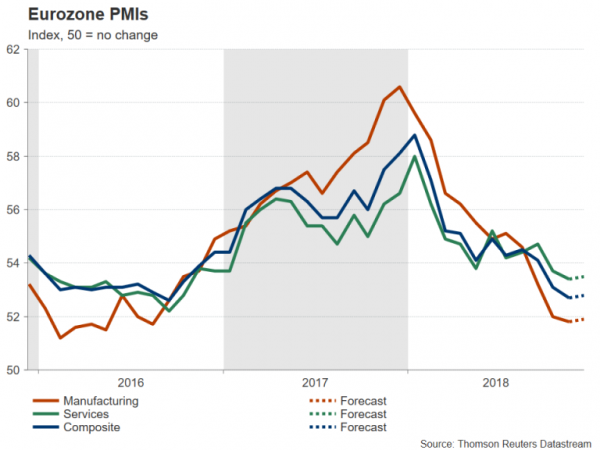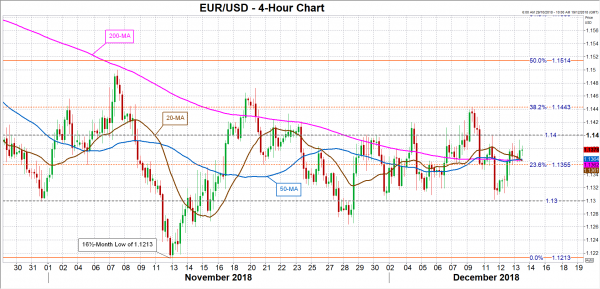The Eurozone’s flash PMIs from IHS Markit will be hitting the headlines on Friday at 0900 GMT. The closely watched indicators of economic activity in the euro area have been pointing downwards since the turn of the year, but there have been some signs lately that growth is at a turning point. While the euro stands to gain from any upturn in growth, Italy and Brexit woes are likely to limit any significant rebound in the currency.
The composite PMI, which combines both the manufacturing and services PMIs, fell to a two-year low of 52.7 in November as growth in the bloc’s largest economy, Germany, slowed to a four-year trough. Italy was another underperformer but the PMIs for other Eurozone countries were more encouraging, with output up in France, Spain and Ireland.
However, even in Germany, whose economy contracted by 0.2% in the third quarter, appears to be seeing some sort of a turnaround. Exports from Germany rebounded by more than expected in October, while industrial output posted a surprise increase during the same month. German business confidence is also improving, with the ZEW economic sentiment for December beating analysts’ expectations. The recent easing of Sino-US trade tensions could be one of the factors contributing to the brightening outlook.
The Eurozone composite PMI is forecast to inch up to 52.8 in the preliminary reading for December, with the manufacturing and services PMIs expected to rise by 0.1 percentage points each to 51.9 and 53.5, respectively.
But even if the current trade truce between China and the US was to lead to a more permanent and enhanced trade arrangement between the two countries, there are several risks closer to home still weighing on investor morale in the euro area. The potential dangers to the Eurozone economy from Britain crashing out of the EU without a deal, Italy not backing down on its plans to raise its 2019 budget deficit target, and the US imposing higher tariffs on European car imports have not fully subsided and are very much present.
This implies traders will want to see more evidence that growth is recovering before concluding that the Eurozone is out of the woods. The political uncertainties, weakening growth outlook and possibility of higher US trade barriers have recently dragged the euro to 16½-month lows even as the European Central Bank prepares to end its asset purchases at the end of December.
A positive surprise in the PMI figures could help the single currency break above the nearest key resistance at the $1.14 handle. Clearing this hurdle would open the way for the next major obstacle – the 38.2% Fibonacci retracement of the downleg from $1.1815 to $1.1213, at $1.1443. Higher up, the 50% Fibonacci could be targeted by the bulls at $1.1514.
However, another miss in the Eurozone PMIs would deepen the gloomy sentiment for the region and could pull the euro below the immediate support zone between the moving averages around $1.1362 and the 23.6% Fibonacci retracement at $1.1355. A dip below this region would bring into scope the psychological $1.13 level, while sharper losses would risk a breach of the 16½-month low of $1.1213 set in November.
















